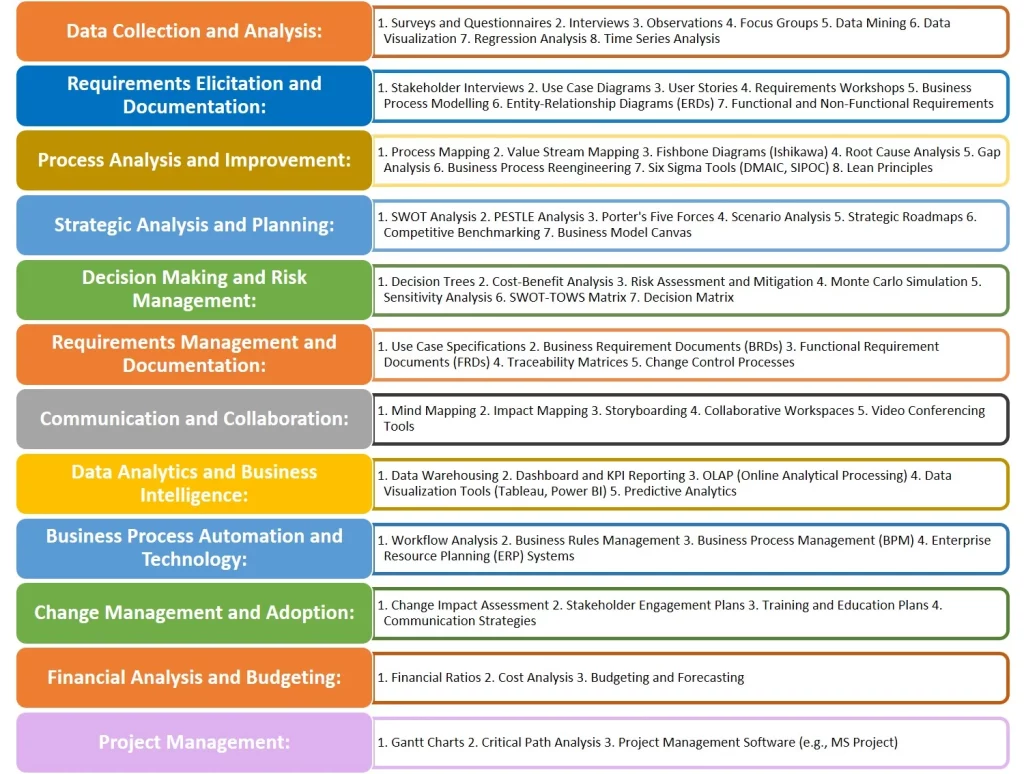
Business analysis involves a variety of tools and techniques that aid professionals in understanding business needs, identifying solutions, and making informed decisions. Below is a categorization and discussion of these tools and techniques:
Data Collection and Analysis Tools
- Surveys and Questionnaires:
- Interviews:
- Observations:
- Focus Groups:
- Data Mining:
- Data Visualization:
- Regression Analysis:
- Time Series Analysis:
These tools play crucial roles in collecting and analyzing data for decision-making, research, and problem-solving across various business contexts. The choice of tool depends on the research objectives, the type of data, and the insights you’re seeking to uncover.
Requirements Elicitation and Documentation Tools
- Stakeholder Interviews:
- Use Case Diagrams:
- User Stories:
- Requirements Workshops:
- Business Process Modeling:
- Entity-Relationship Diagrams (ERDs):
- Functional and Non-Functional Requirements:
- Business Requirement Documents (BRDs):
- Functional Requirement Documents (FRDs):
- Traceability Matrices:
- Change Control Processes:
These tools facilitate the process of understanding and clarifying requirements, which are essential for designing and building effective solutions, systems, or products. Elicitation tools help extract information from stakeholders, while documentation tools help organize and present these requirements in a clear and structured manner. Effective use of these tools helps ensure that project stakeholders’ needs are captured accurately and translated into actionable specifications.
Process Analysis and Improvement Tools
- Process Mapping:
- Value Stream Mapping:
- Fishbone Diagrams (Ishikawa):
- Root Cause Analysis:
- Gap Analysis:
- Business Process Reengineering:
- Six Sigma Tools (DMAIC, SIPOC):
- Lean Principles:
These tools and techniques are essential for analyzing existing processes, identifying areas for improvement, diagnosing process-related challenges, and implementing changes to enhance efficiency, effectiveness, optimize performance, reduce waste, and enhance overall productivity within organizations.
Strategic Analysis and Planning Tools
- SWOT Analysis:
- PESTLE Analysis:
- Porter’s Five Forces:
- Scenario Analysis:
- Strategic Roadmaps:
- Competitive Benchmarking:
- Business Model Canvas:
These strategic analysis and planning tools offer frameworks and methodologies to analyze an organization’s internal and external environment, formulate strategies, make informed decisions, and adapt to changing conditions in a dynamic business landscape.
Decision Making and Risk Management Tools
- Decision Trees:
- Cost-Benefit Analysis:
- Risk Assessment and Mitigation:
- Monte Carlo Simulation:
- Sensitivity Analysis:
- SWOT-TOWS Matrix:
- Decision Matrix:
These decision-making and risk management tools enable organizations to assess options, consider potential outcomes, and make informed choices that align with their objectives and values. By addressing uncertainty and considering multiple perspectives, these tools support strategic and operational decision-making processes.
Communication and Collaboration Tools
- Mind Mapping:
- Impact Mapping:
- Storyboarding:
- Collaborative Workspaces:
- Video Conferencing Tools:
These communication and collaboration tools enhance teamwork, idea sharing, and project management by providing efficient ways to visualize concepts, align goals, organize information, and maintain effective communication among team members, even in remote or distributed work environments.
Data Analytics and Business Intelligence Tools
- Data Warehousing:
- Dashboard and KPI Reporting:
- OLAP (Online Analytical Processing):
- Data Visualization Tools (Tableau, Power BI):
- Predictive Analytics:
These data analytics and business intelligence tools empower organizations to transform raw data into actionable insights, enabling informed decision-making, identifying trends, and optimizing business processes. By leveraging these tools, businesses gain a competitive advantage by leveraging data to its full potential.
Business Process Automation and Technology Tools
- Workflow Analysis:
- Business Rules Management:
- Business Process Management (BPM):
- Enterprise Resource Planning (ERP) Systems:
These Business Process Automation and Technology Tools play a pivotal role in modernizing and optimizing business operations. They contribute to increased efficiency, accuracy, and agility by automating tasks, streamlining workflows, enforcing rules, and integrating data and processes across an organization.
Change Management and Adoption Tools
- Change Impact Assessment:
- Stakeholder Engagement Plans:
- Training and Education Plans:
- Communication Strategies:
These change management and adoption tools are critical in navigating the challenges associated with organizational change. They help assess, plan, and execute change initiatives in a way that minimizes disruption, maximizes stakeholder engagement, and promotes successful adoption and integration of new practices or technologies.
Financial Analysis and Budgeting Tools
- Spreadsheet Software (e.g., Microsoft Excel, Google Sheets):
- Financial Ratios and Metrics:
- Cost Analysis:
- Budgeting and Forecasting Tools:
- Cash Flow Analysis Tools:
- Financial Reporting Software:
- Business Intelligence (BI) Tools:
- Enterprise Resource Planning (ERP) Systems:
- Capital Budgeting Techniques:
These Financial Analysis and Budgeting Tools are essential for organizations to evaluate their financial health, allocate resources efficiently, and make informed decisions that align with their financial objectives.
Project Management Tools
- Gantt Charts:
- Critical Path Analysis:
- Project Management Software (e.g., MS Project):
These Project Management Tools are integral for planning, organizing, and executing projects successfully. They help project managers and teams streamline processes, allocate resources, manage tasks, and monitor progress, ultimately ensuring that projects are completed on time and within scope.
In summary, these categories encompass a wide range of tools and techniques that business analysts utilize to perform their roles effectively and support decision-making across various aspects of an organization. The choice of tools and techniques depends on the specific needs and challenges of the project or analysis at hand.
